Chapter 15 - Temporal Lobes
0.0(0)
0.0(0)
Card Sorting
1/142
Earn XP
Description and Tags
Study Analytics
Name | Mastery | Learn | Test | Matching | Spaced |
|---|
No study sessions yet.
143 Terms
1
New cards
symptoms of temporal-lobe disorder?
* transformed personality
* he got a left-temporal lobe tumor → was removed
* aphasic after surgery (clear after a few weeks)
* word-find difficulties
* verbal-memo probs
* including radical changes in affect (emotion) and personality, memory disturbance, and at least a transient disturbance of language
* he got a left-temporal lobe tumor → was removed
* aphasic after surgery (clear after a few weeks)
* word-find difficulties
* verbal-memo probs
* including radical changes in affect (emotion) and personality, memory disturbance, and at least a transient disturbance of language
2
New cards
what does the temporal lobe comprise all of?
the tissue that lies below the lateral (Sylvian) fissure and anterior to the occipital cortex
* subcortical structs:
* limbic sys, amygdala, hippo formation
* subcortical structs:
* limbic sys, amygdala, hippo formation
3
New cards
how many temporal areas did Brodmann identify?
* 10
* but recent studies found more areas in monkey brain
* but recent studies found more areas in monkey brain
4
New cards
the divisions of temporal lobes?
* auditory (Brodmann’s area, 41, 42, 22)
* for the ventral visual stream on the lateral temporal lobe (area 20,21, 37, 38)
* for the ventral visual stream on the lateral temporal lobe (area 20,21, 37, 38)

5
New cards
what are the visual regions referred to as?
inferotemporal cortex or area TE

6
New cards
what does the lateral (sylvian) fissure form?
insula → includes gustatory cortex + auditory association cortex
7
New cards
what does the STS seperate?
the superior and middle temporal gyri and houses a sig amount of neocortex

8
New cards
what is the medial temporal cortex?
* limbic cortex
* includes amygdala and adjacent cortex (uncus), hippo, and surrounding cortex (subiculum, entorhinal cortex, perirhinal cortex), and fufiform gyrus
* includes amygdala and adjacent cortex (uncus), hippo, and surrounding cortex (subiculum, entorhinal cortex, perirhinal cortex), and fufiform gyrus
9
New cards
bordmann’s area for entorhinal cortex?
area 28
10
New cards
what does area 35 and 36 correspond to?
perirhinal cortex
11
New cards
what are cortical areas TH and TF often referred to as?
parahippocampal cortex
12
New cards
what are the fusiform gyrus and inferior temporal gyrus functionally part of?
the lateral temporal cortex
13
New cards
what is the cortical region lying along the boundary of the temporal and parietal lobes often called?
temporal-parietal junction (TPJ)
14
New cards
when is TPJ shown to be active?
* attention
* memo
* language
* social processing
* so it proposed as central to decision making in a social context
* memo
* language
* social processing
* so it proposed as central to decision making in a social context
15
New cards
what are the afferent projections involved?
sensory sys
16
New cards
where are the efferent projections involved?
* parietal and frontal associations regions
* limbic sys
* basal ganglia
* limbic sys
* basal ganglia
17
New cards
how is the neocortex of the left and right temporal lobe connected ?
by corpus callosum
18
New cards
how is medial temporal cortex and amygdala connected?
anterior commissure
19
New cards
what are the types of cortical-cortical connections found?
1. hierarchical sensory pathway subserves stimulus recog
2. a dorsal auditory pathway is concerned with directing movements with respect to auditory info
3. a polymodal pathway prob underlies stimulus categorization
4. a medial temporal projection crucial to LTM
5. a frontal lobe projection necessary for various aspects of movement control, STM, and affect
20
New cards
what is the hierarchical sensory pathway subserves the stimulus recog?
* hierarchical progression of connections emanates from teh primary and secondary auditory and visual areas, ending in the temporal pole. T
* he visual projections form the ventral stream of visual processing, whereas the auditory projections form a parallel ventral stream of auditory processing
\
* he visual projections form the ventral stream of visual processing, whereas the auditory projections form a parallel ventral stream of auditory processing
\
21
New cards
expand on the second cortical-cortical connection :A dorsal auditory pathway is concerned with directing movements with respect to auditory information
* projections from the auditory areas to the posterior parietal cortex, this pathway is analogous to part of the dorsal visual pathway, which likely plays a role in detecting the spatial location of auditory inputs
22
New cards
expand on the third cortical-cortical connection :A polymodal pathway probably underlies stimulus categorization.
this series of parallel projections from teh visual and auditory association areas converges in the polymodal regions of the STS
23
New cards
expand on the forth find cortical-cortical connection :A medial temporal projection crucial to long-term memory
* the projection from the auditory and visual association areas into the medial temporal, or limbic, regions goes first to the perirhinal cortex, then to the entorhinal cortex, and finally into the hippo formation or the amygdala or both.
* the hippo projection forms the **perforant pathway** → when disrupted, results in major dysfunc of hippocampal activity
* the hippo projection forms the **perforant pathway** → when disrupted, results in major dysfunc of hippocampal activity
24
New cards
\
expand of the fifth cortical-cortical connection: A frontal-lobe projection necessary for various aspects of movement control, short-term memory, and affect
expand of the fifth cortical-cortical connection: A frontal-lobe projection necessary for various aspects of movement control, short-term memory, and affect
this series of parallel projections reaches from the temporal association areas to the frontal lobe
25
New cards
how many cortical and subcortical pathways comprise the ventral stream?
at least 6
26
New cards
where are projections in the first set subcortical go (in ventral stream)?
* from every region of the occipitotemporal pathway to the neostriatum (striatum)
* projections for the occipitotemoral-neostriatial network to support types of habit and skill learning depedent on vision
* projections for the occipitotemoral-neostriatial network to support types of habit and skill learning depedent on vision
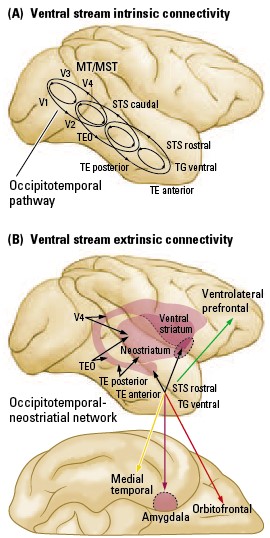
27
New cards
what is the striatum comprised of?
caudate nucleus and plutamen of the basal ganglia
28
New cards
where are projections headed in second pathway of ventral stream go and do?
* amygdala-bound projections from inferotemporal regions
* allow processing of emotionally salient stimuli
* allow processing of emotionally salient stimuli
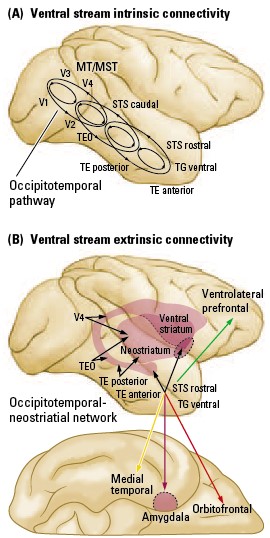
29
New cards
where are projections headed in third pathway of ventral stream go and do?
* travels from inferotemporal cortex to ventral striatum (nucleus accumbens)
* support the assignments of stimulus valence (potency)
* support the assignments of stimulus valence (potency)
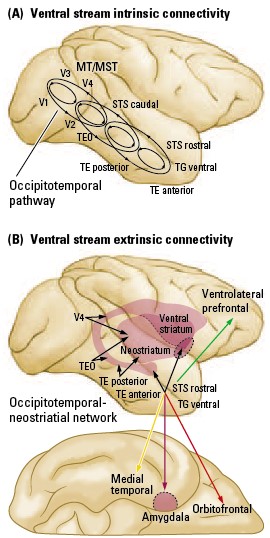
30
New cards
where do three remaining pathways in ventral stream project and do?
* from inferotemporal cortex to other cortical regions
* medial temporal → LTM
* orbitofrontal pathway → object-reward associations
* ventrolateral prefrontal → object WM
* medial temporal → LTM
* orbitofrontal pathway → object-reward associations
* ventrolateral prefrontal → object WM
31
New cards
what does the temporal cortex house?
* primary auditory cortex
* secondary auditory and visual cortex
* limbic cortex
* amygdala
* hippo
* secondary auditory and visual cortex
* limbic cortex
* amygdala
* hippo
32
New cards
what are the three basic sensory func of temporal cortex?
1. processing auditory input
2. visual obj recog
3. LTM of sensory input → memo
33
New cards
what is the func of ventral stream pathway?
* obj recog by characteristics such as shape, colour, size
* categorization
* categorization
34
New cards
what does obj categorization depend on (region)?
inferortemporal cortex, area TE
35
New cards
what does damage to temporal cortex lead to?
deficits in identifying and categorizing stimuli
36
New cards
what is cross-modal matching and depends on what region?
* matching visual and auditory info
* depends on the cortex of the superior temporal sulcus
* depends on the cortex of the superior temporal sulcus
37
New cards
LTM depends on what?
ventral stream and paralimbic cortex of the medial temporal region
38
New cards
affective response is a func of what?
amygdala
Associating sensory input and emotion is crucial for learning because stimuli become associated with their positive, negative, or neutral consequences, and behavior is modified accordingly.
Associating sensory input and emotion is crucial for learning because stimuli become associated with their positive, negative, or neutral consequences, and behavior is modified accordingly.
39
New cards
what happens in absence of affective system?
* all stimuli would be treated equivalently → can be consequential
* e.g., fail to associate rattle snake with consequence of being bitten
* e.g., fail to associate rattle snake with consequence of being bitten
40
New cards
what happens when amygdala gets lesion?
become very placid and do not react emotionally to threatening stimuli.
41
New cards
what subcortical region helps us use spatial nagivation?
hippo → contains cells that code places in space
42
New cards
what is biological motion?
movements that have particular relevance to a species
43
New cards
what region analyzes movement?
STS
44
New cards
what is social cog?
theory of mind that allows us to dev hypotheses abt other people’s intentions
45
New cards
what info in important for social cog?
social perception
46
New cards
what area play a key role in social cog?
cells in STS
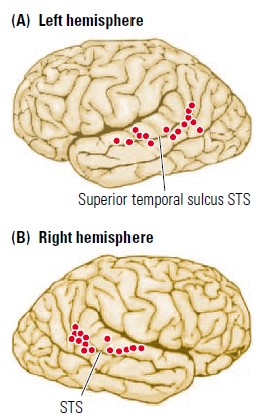
47
New cards
what could also be involved in perceiving species-typical sounds (vocalization)?
STS and cells in superior temporal gyrus
48
New cards
what can talking and signing be perceived as?
* a complex form of biological motion
* so activation of STS in response to mouth movement too
* so activation of STS in response to mouth movement too
49
New cards
if people have temporal lobe injuries that lead to impairments in analyzing biological motion, there is likely a correlated deficit in _________ ________________
social awareness
50
New cards
what do neurons in STS may be particularly responsive to?
* faces seen head-on
* faces viewed in profile
* posture of the head
* particular facial expressions
* faces viewed in profile
* posture of the head
* particular facial expressions
51
New cards
what cells are maximally sensitive to primate bodies moving in a particular direction?
STS cells

52
New cards
what did scientist notice in experiment of watching the good, the bad and the ugly?
1. extensive activity throughout the entire temporal lobe was highly correlated across participants → same for auditory and visual areas in temporal lobe, STS and cingulate regions → shows stereotypic response to naturalistic audiovisual stimuli
2. selective activation related to the film’s precise moment-to-moment content
* close up for face → FFA highly active
* broad scene → enhance activity of PPA
3. no intersubject coherence → they have widely diff thought patters beyond the sensory processing, related to past experience.
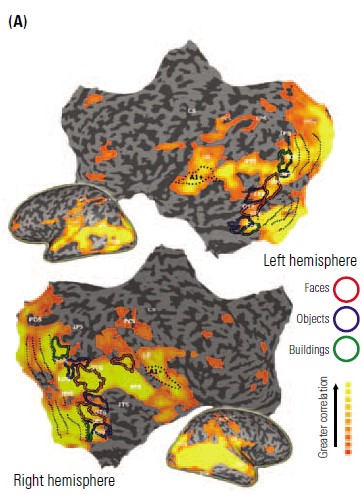
53
New cards
in study, what do activation for most cells in area TE require?
* complex features containing a combo of characteristics such as orientation, size, colour, and texture
54
New cards
what do cells with similar, although slightly diff, selectively tend to do?
cluster vertically in columns
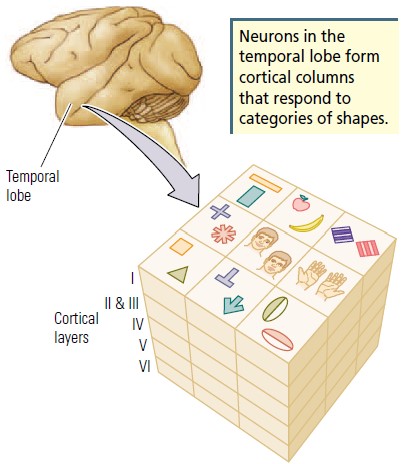
55
New cards
how would obj be likely represented in columnar organization in area TE?
by the activation of many cells within a columnar module
→ they largely overlap to minimize the effect of small changes in input images and lead to the categorization of similar obj
→ they largely overlap to minimize the effect of small changes in input images and lead to the categorization of similar obj
56
New cards
what did study on inferotemporal find that experience alters?
the stimulus specificity → is a experience-dependent characteristic
57
New cards
what does experience-dependent characteristic allow us to do?
allows the visual sys to adapt to diff demands in a changing visual enviro → important for human visual recog abilities that face differing demands depending on the type of eviro they are confronting
58
New cards
inferotemporal neurons not only may process visual input but also may provide what?
a mechanism for internally representing images of obj → may provide basis for WM and visual imagery
59
New cards
what are evidence that a special pathway exists in visual sys for analyzing faces?
1. study sows that neurons in temporal lobe specifically tuned to diff faces, with some cells attuned to facial identity and others to facial expression
2. inverted photographs of any obj that has a usual right side up makes it harder to recog, but the effect on faces in disproportionate
60
New cards
what illusion shows the importance of an upright orientation for facial perception?
Thatcher Illusion

61
New cards
are inverted faces and upright faces processed in the same regions?
* no
* upright has separate face-perception sys that includes regions in the occipital lobe as well as several different temporal lobe regions
* upright has separate face-perception sys that includes regions in the occipital lobe as well as several different temporal lobe regions
62
New cards
what do right temporal lesions lead to?
greater effect on facial processing than left
63
New cards
what are results of split face test?
* participants consistently chose the left-side of photography A when asked which resembled photo A the most.
* did this when photos were inverted, or upright
* patients w/ either right temporal or parietal removals consistently failed to match any conditions
* did this when photos were inverted, or upright
* patients w/ either right temporal or parietal removals consistently failed to match any conditions
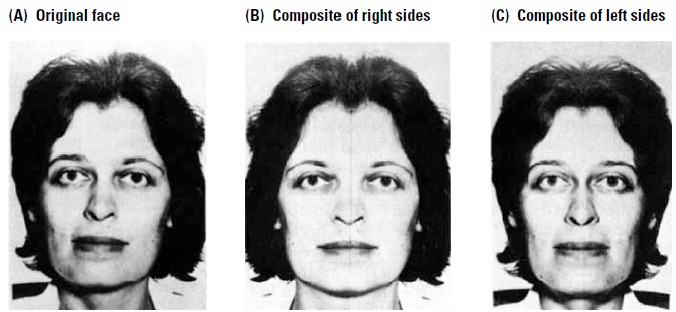
64
New cards
would the person in photograph chose the same as someone else in split-faces test?
* no it will be reversed → we will chose right side
* bc we see ourselves differently in mirror than others see
* bc we see ourselves differently in mirror than others see
65
New cards
sound wave path to brain?
cochlea → brainstem → auditory cortex → perception of sound
66
New cards
what kind of map do auditory regions have?
tonotopic maps → gol is to perceive sound making obj, locate sound, and make movements in relation to sounds
67
New cards
many cells in auditory cortex respond to specific _________?
frequencies
68
New cards
another word for frequencies?
sound pitch
69
New cards
what are the two most interesting sounds to human?
lang + music
70
New cards
how does speech differ from other auditory inputs?
1. speech sounds come largely from three restricted frequency ranges known as formants
* syllables differ both in onset frequency of the second (higher) formant and in the onset time of the consonant
* vowel sounds occupy a const f band
* consonants show rapid change in f
2. the same speech sounds vary from one context in which they are heard to another, yet all are perceived as being the same
* auditory sys must have mecha for categorizing varying sounds as equivalent, and this mecha must be affected by experience, bc obstacle learning lang as adult
3. speech sounds change vv rapidly in relation to one another, and the sequence of the sounds is critical to understanding
71
New cards
what does music rely on?
* relations between auditory ele
72
New cards
what does lang depend on?
individual auditory ele
73
New cards
what is tune defined by?
arrangement of the pitches’ durations and interval between them
74
New cards
what do musical sounds differ from one another by?
* loudness
* timber
* pitch
* timber
* pitch
75
New cards
what is loudness refer to?
subjective magnitude of an auditory sensation judged by a given person as “vv loud”, “soft”, “very soft”, etc.
76
New cards
what is intensity measured in?
decibels → intensity
77
New cards
what does timbre refer to?
* the distinctive character of a sound, the quality that distinguishes it from all other sounds of similar pitch and loudness
* e.g., can distinguish trombone and violin by sound even if play same note
* e.g., can distinguish trombone and violin by sound even if play same note
78
New cards
what is pitch?
position of a sound in a musical scale
79
New cards
what is pitch related to ?
frequency → vibration of sound wave
80
New cards
what does pitch contribute to in regards of speech?
prosody → “tone” of voices
81
New cards
what is the lowest component of a note called?
fundamental f
82
New cards
what are f above fundamental called?
overtones or partials → they are multiples of fundamentals → harmonics
83
New cards
what is periodicity pitch?
when a fundamental f is removed from a note by means of electronic filters, overtones are sufficient to determine the pitch of the fundamental f
84
New cards
what is an important aspect of pitch perception?
although we can generate (and perceive) the fundamental f, we still perceive the complex tones of the harmonics, or spectral pitch
85
New cards
what region seems to make periodicity - pitch discrimination?
auditory cortex of the right temporal lobe
86
New cards
patients with right temporal lobectomies that include primary auditory cortex are impaired at what?
* making pitch discrimination when the fundamental is absent but make discrimination normally when fundamental is present
* also impaired at identifying the direction of a pitch change
* also impaired at identifying the direction of a pitch change
87
New cards
other name for primary auditory cortex?
area 41 → Heschl’s gyrus
88
New cards
what types of time relations are fundamental to the ryth musical sequences?
* segmentation of sequences of pitches into groups based on the duration of the sounds and identification of temporal regularity (beat)
89
New cards
other word for beat?
meter
90
New cards
what regions plays role in temporal grouping for rhythm?
left temporal lobe
91
New cards
what region plays role in meter?
right temporal lobe
92
New cards
what regions play a role in motor component of rhythm?
* supplementary motor cortex
* premotor cortex
* cerebellum
* basal ganglia
* premotor cortex
* cerebellum
* basal ganglia
93
New cards
injury where impairs learning melodies?
* either temporal lobes
94
New cards
what region injured leads to impairment of melody retention?
right temporal
95
New cards
the right temporal lobe has a special func of extracting ______ from sounds, whether sound is speech or music
pitch
96
New cards
there is a moch larger volume of what in Heschl’s gyrus in both temporal lobes in musicians?
grey and white matter
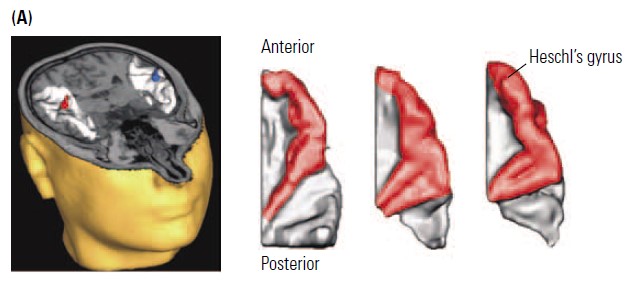
97
New cards
what does the gray-matter difference positively correlate to?
musical aptitude → the greater aptitude, the larger the gray-matter volume
98
New cards
what do fundamental-pitch listeners exhibit?
pronounced leftward asymmetry of gray matter volume in Heschl’s gyrus
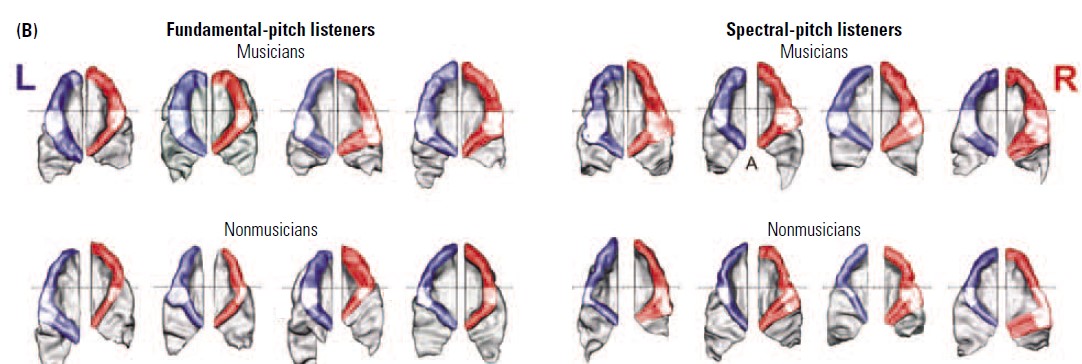
99
New cards
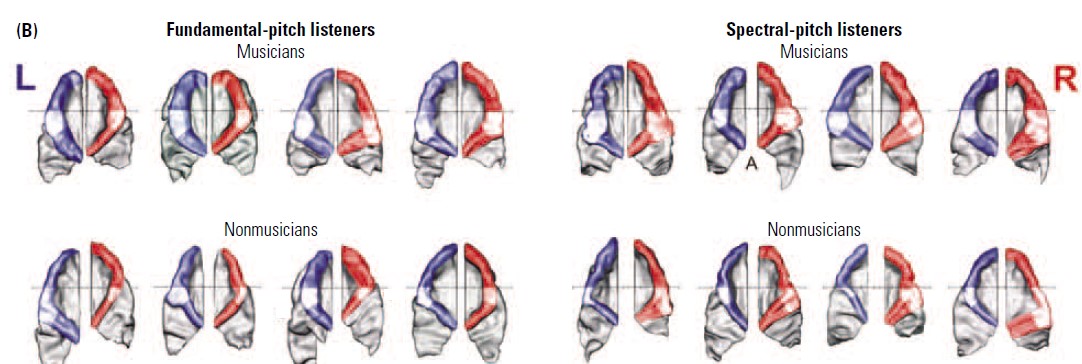
what do spectral-pitch listeners exhibit?
rightward asymmetry, independent of music training
100
New cards
what do innate differences in brain morphology relate to?
the way in which pitch is processed and that some innate differences are related to music ability